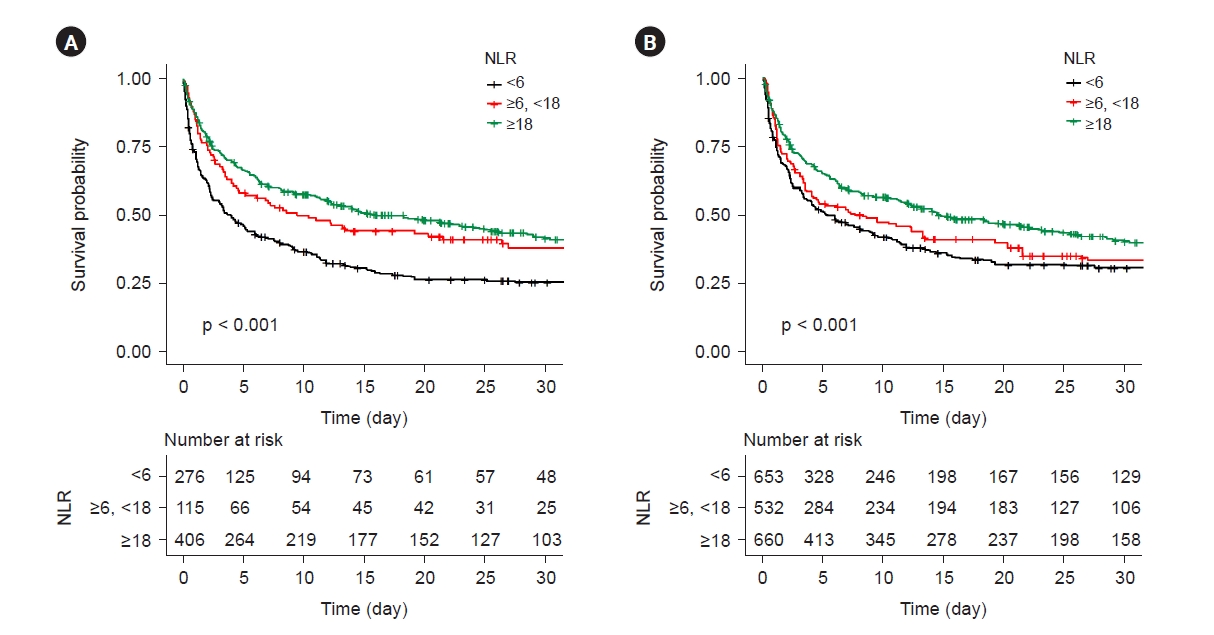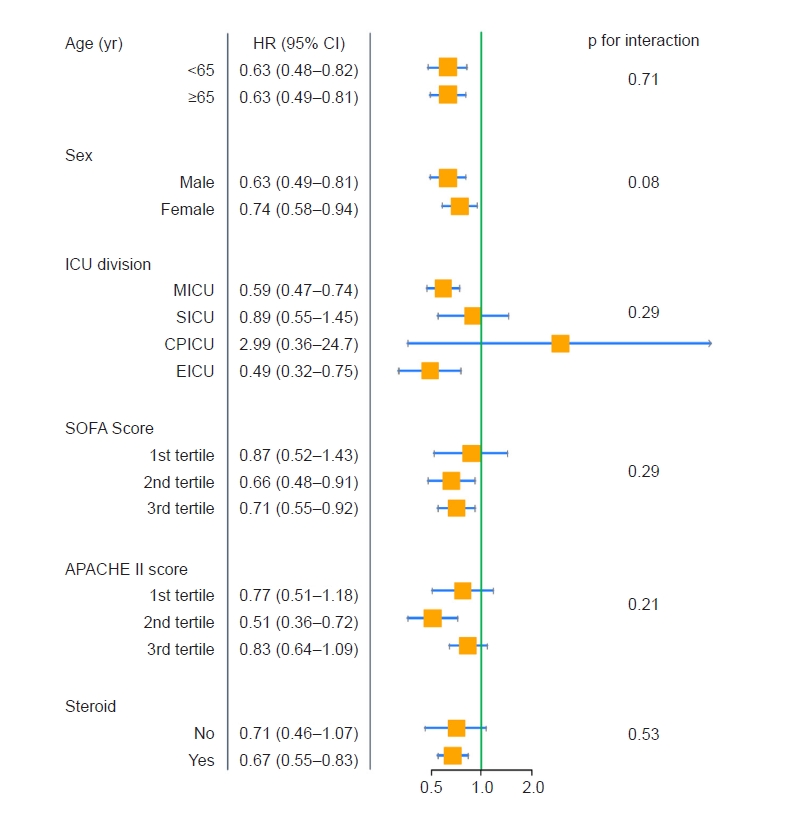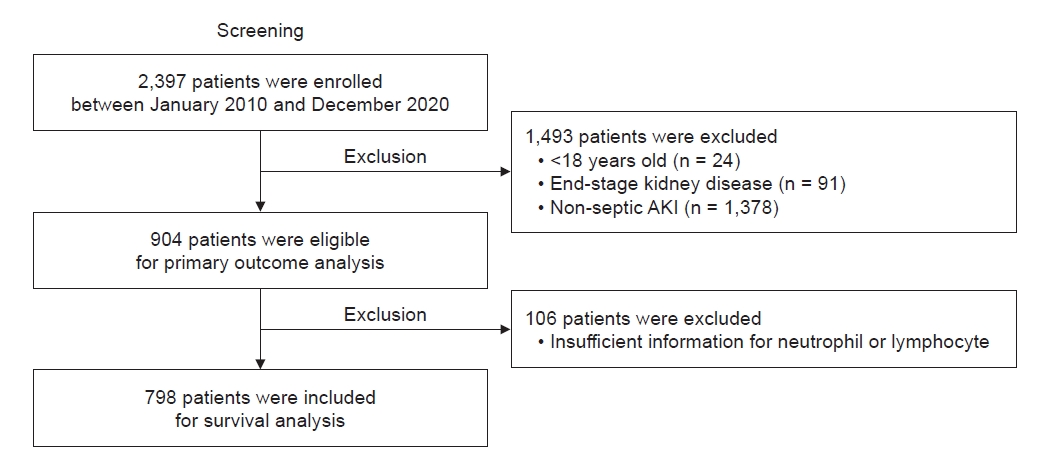| Kidney Res Clin Pract > Epub ahead of print |
Abstract
Background
Methods
Results
Supplementary Materials
Notes
Figure 2.
Kaplan-Meier survival curves.

Figure 3.
Forest plot for subgroup analysis.

Table 1.
| Variable | Total |
Neutrophil-lymphocyte ratio |
p-value | ||
|---|---|---|---|---|---|
| <6 | ≥6, <18 | ≥18 | |||
| No. of patients | 798 | 277 | 115 | 406 | |
| Age (yr) | 64.2 ± 14.5 | 64.0 ± 14.9 | 65.7 ± 13.1 | 65.1 ± 11.6 | 0.62 |
| Male sex | 503 (63.0) | 177 (63.9) | 73 (63.5) | 228 (56.2) | 0.37 |
| Body mass index (kg/m2) | 23.0 ± 4.4 | 23.0 ± 4.3 | 23.2 ± 4.7 | 22.9 ± 4.4 | 0.79 |
| ICU division | 0.02* | ||||
| MICU | 466 (58.4) | 166 (59.9) | 48 (41.7) | 210 (51.7) | |
| EICU | 167 (20.9) | 53 (19.1) | 31 (27.0) | 132 (32.5) | |
| SICU | 140 (17.5) | 50 (18.1) | 28 (24.3) | 51 (12.6) | |
| CPICU | 21 (2.6) | 7 (2.5) | 8 (7.0) | 9 (2.2) | |
| DICU | 4 (0.5) | 1 (0.4) | 0 (0.0) | 4 (1.0) | |
| Inotropics use | 388 (48.6) | 135 (48.7) | 56 (48.7) | 192 (47.3) | 0.96 |
| Mechanical ventilator | 622 (77.9) | 219 (79.1) | 81 (70.4) | 292 (71.9) | 0.15 |
| Catheter | 0.85 | ||||
| Femoral | 424 (53.1) | 145 (52.3) | 62 (53.9) | 237 (58.4) | |
| Intrajugular | 280 (35.1) | 98 (35.4) | 42 (36.5) | 128 (31.5) | |
| Others | 94 (11.8) | 34 (12.3) | 11 (9.6) | 41 (10.1) | |
| Blood flow rate (mL/min) | 113.9 ± 24.8 | 113.9 ± 25.1 | 110.5 ± 22.8 | 115.4 ± 23.6 | 0.58 |
| Target dose (mL/kg/hr) | 46.7 ± 18.8 | 46.5 ± 18.7 | 48.5 ± 18.9 | 47.6 ± 19.3 | 0.71 |
| Target ultrafiltration (mL/day) | 0 (0–500) | 0 (0–500) | 0 (0–700) | 0 (0–500) | 0.43 |
| Anuria | 239 (29.9) | 84 (30.3) | 25 (21.7) | 129 (31.8) | 0.58 |
| CCI score | 3 (2–4) | 3 (2–4) | 3 (1–3) | 3 (2–4) | 0.32 |
| SOFA score | 12.8 ± 3.7 | 12.7 ± 3.7 | 12.7 ± 3.8 | 13.7 ± 3.3 | 0.03* |
| APACHE II score | 27.4 ± 7.7 | 27.3 ± 7.8 | 26.5 ± 7.2 | 27.8 ± 7.4 | 0.64 |
| Co-morbidities (%) | |||||
| Hypertension | 284 (35.6) | 84 (30.3) | 44 (38.3) | 156 (38.4) | 0.08 |
| Diabetes Mellitus | 246 (30.8) | 73 (26.4) | 45 (39.1) | 127 (31.3) | 0.04* |
| Cardiovascular disease | 93 (11.7) | 22 (7.9) | 16 (13.9) | 55 (13.5) | 0.06 |
| Steroid use | 536 (67.2) | 227 (81.9) | 53 (46.1) | 256 (63.1) | <0.001* |
| IV hydrocortisone equivalent (mg/day) | 200 (0–100) | 200 (0–100) | 25 (0–200) | 150 (0–200) | <0.001* |
| Infection source | <0.001* | ||||
| Intra-abdominal | 247 (31.0) | 68 (24.5) | 34 (29.6) | 145 (35.7) | |
| Respiratory | 242 (30.3) | 60 (21.7) | 40 (34.8) | 142 (35.0) | |
| Hematologic/oncologic/ immunocompromised | 184 (23.1) | 118 (42.6) | 18 (15.7) | 48 (11.8) | |
| Kidney | 47 (5.9) | 8 (2.9) | 7 (6.1) | 32 (7.9) | |
| Skin/soft tissue/bone | 38 (4.8) | 13 (4.7) | 5 (4.3) | 20 (4.9) | |
| Others | 28 (3.5) | 6 (2.2) | 8 (7.0) | 14 (3.4) | |
| Source unknown/not specified | 12 (1.5) | 4 (1.4) | 3 (2.6) | 5 (1.2) | |
| Total WBC (×103/µL) | 14.8 ± 23.2 | 10.9 ± 30.5 | 15.5 ± 19.1 | 17.1 ± 17.6 | 0.003* |
| Hemoglobin (g/dL) | 9.5 ± 2.3 | 9.4 ± 2.4 | 9.5 ± 2.6 | 9.6 ± 2.2 | 0.55 |
| Platelet (×103/µL) | 107.8 ± 98.7 | 82.7 ± 76.4 | 135.2 ± 117.6 | 117.1 ± 102.9 | <0.001* |
| Neutrophil (%) | 72.1 ± 27.4 | 46.3 ± 29.5 | 78.0 ± 14.2 | 87.9 ± 10.5 | <0.001* |
| Lymphocyte (%) | 14.0 ± 19.7 | 29.9 ± 25.9 | 9.3 ± 4.8 | 4.5 ± 6.0 | <0.001* |
| Monocyte (%) | 5.4 ± 6.5 | 6.6 ± 8.7 | 6.5 ± 6.7 | 4.2 ± 4.0 | <0.001* |
| Absolute neutrophil count (/µL) | 11,284.6 ± 15,376.1 | 4,591.9 ± 9,935.6 | 12,291.1 ± 15,959.8 | 15,546.8 ± 16,640.7 | <0.001* |
| Albumin (g/dL) | 2.5 ± 0.6 | 2.4 ± 0.6 | 2.6 ± 0.6 | 2.6 ± 0.6 | 0.02* |
| C-reactive protein (mg/dL) | 16.6 ± 11.3 | 18.1 ± 12.1 | 15.4 ± 10.9 | 16.0 ± 10.9 | 0.027* |
| Serum creatinine (mg/dL) | 2.8 ± 2.0 | 2.4 ± 1.3 | 3.1 ± 1.9 | 3.1 ± 2.3 | <0.001* |
| Estimated GFR (mL/min/1.73 m2) | 30.9 ± 22.9 | 35.9 ± 25.0 | 29.0 ± 21.9 | 28.0 ± 21.1 | <0.001* |
| Sodium (mmol/L) | 136.3 ± 7.8 | 138.0 ± 7.6 | 136.4 ± 8.1 | 135.2 ± 7.7 | <0.001* |
| Potassium (mmol/L) | 4.5 ± 1.0 | 4.4 ± 1.0 | 4.6 ± 1.0 | 4.6 ± 1.0 | 0.03* |
| Chloride (mmol/L) | 102.3 ± 8.4 | 103.5 ± 8.3 | 102.3 ± 8.5 | 101.5 ± 8.3 | 0.009* |
| HCO3– (mmol/L) | 16.9 ± 5.3 | 16.0 ± 4.9 | 17.2 ± 5.7 | 17.5 ± 5.3 | 0.001* |
Data are expressed as number only, mean ± standard deviation, number (%), or median (interquartile range).
APACHE, acute physiologic and chronic health evaluation; CCI, Charlson Comorbidity Index; CPICU, cardio-pulmonary intensive care unit; DICU, disaster intensive care unit for coronavirus disease 2019 infection; EICU, emergency intensive care unit; GFR, glomerular filtration rate; ICU, intensive care unit; IV, intravenous; MICU, medical intensive care unit; SICU, surgical intensive care unit; SOFA, Sequential Organ Failure Assessment; WBC, white blood cell.
Table 2.
| Variable | Total (n = 798) |
Neutrophil-lymphocyte ratio |
p-value | ||
|---|---|---|---|---|---|
| <6 (n = 277) | ≥6, <18 (n = 115) | ≥18 (n = 406) | |||
| On CRRT mortality | 490 (61.4) | 195 (70.4) | 70 (60.9) | 225 (55.4) | <0.001* |
| ICU mortality | 533 (66.8) | 207 (74.7) | 75 (65.2) | 251 (61.8) | 0.002* |
| In-hospital mortality | 604 (75.7) | 231 (83.4) | 86 (74.8) | 286 (70.4) | 0.001* |
Table 3.
| Model | NLR | HR (95% CI) | p-value |
|---|---|---|---|
| Model 1a | <6 | Reference | |
| ≥6, <18 | 0.71 (0.54–0.92) | 0.01* | |
| ≥18 | 0.63 (0.52–0.76) | <0.001* | |
| Model 2b | <6 | Reference | |
| ≥6, <18 | 0.71 (0.55–0.93) | 0.01* | |
| ≥18 | 0.62 (0.52–0.75) | <0.001* | |
| Model 3c | <6 | Reference | |
| ≥6, <18 | 0.86 (0.62–1.19) | 0.35 | |
| ≥18 | 0.66 (0.51–0.85) | 0.001* | |
| Model 4d | <6 | Reference | |
| ≥6, <18 | 0.92 (0.70–1.20) | 0.53 | |
| ≥18 | 0.74 (0.61–0.89) | 0.001* |
c Model 2 plus weight, intensive care unit division, presence of anuria, Charlson Comorbidity Index, Sequential Organ Failure Assessment score, and Acute Physiology Assessment and Chronic Health Evaluation II.
References
- TOOLS
-
METRICS

-
- 0 Crossref
- 0 Scopus
- 542 View
- 21 Download
- ORCID iDs
-
Jinwoo Lee

https://orcid.org/0000-0003-0656-9364Jeongin Song

https://orcid.org/0009-0004-2034-1109Seong Geun Kim

https://orcid.org/0000-0002-8831-9838Donghwan Yun

https://orcid.org/0000-0001-6566-5183Min Woo Kang

https://orcid.org/0000-0002-9411-3481Dong Ki Kim

https://orcid.org/0000-0002-5195-7852Kook-Hwan Oh

https://orcid.org/0000-0001-9525-2179Kwon Wook Joo

https://orcid.org/0000-0001-9941-7858Yon Su Kim

https://orcid.org/0000-0003-3091-2388Seung Seok Han

https://orcid.org/0000-0003-0137-5261Yong Chul Kim

https://orcid.org/0000-0003-3215-8681 - Related articles




 PDF Links
PDF Links PubReader
PubReader ePub Link
ePub Link Full text via DOI
Full text via DOI Download Citation
Download Citation Supplement table 1
Supplement table 1 Print
Print















